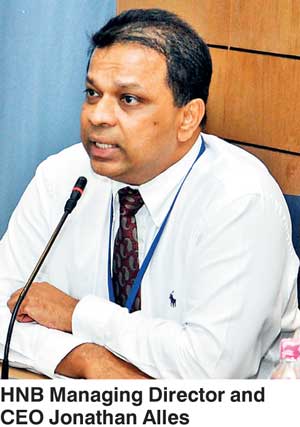Wednesday Dec 24, 2025
Wednesday Dec 24, 2025
Wednesday, 21 March 2018 03:12 - - {{hitsCtrl.values.hits}}
By Uditha Jayasinghe
With credit growth expected to slow down to about 15% in 2018, banks would have to rely on adaptation and deepening core businesses to maintain growth, believes a top industry veteran.
Addressing an investor forum recently Hatton National Bank (HNB) Managing Director Jonathan Alles acknowledged that slowing credit growth and tight monetary policy would present a challenging environment for banks this year but the financial sector would be buttressed by continuing their core businesses and finding new ways to save money through a faster rate of technology adaption and business centralisation.

“Our expectation is that in the overall industry credit growth will not exceed 15% in 2018,” he told the gathering but expressed optimism that planned incentive policies by the government such as introducing 100 microfinance schemes would be an ideal fit for HNB and improve consumption, particularly among Sri Lanka’s rural village communities leading to stronger economic activity.
Prolonged bad weather has had a deep impact on agriculture, noted Alles, spilling over into food processing industries and even exports. If better weather and supportive policies come together then it could provide an opportunity for banks to participate in rejuvenating these sectors. HNB managed to maintain 30% growth in microfinance in 2017 despite challenging circumstances and was confident they could repeat the performance this year. Overall loan growth for last year for HNB was 13.5% somewhat behind its competitors who posted loan expansion around 20%.
“If the Government can hold onto fiscal policy and drive it, so be it. That would be fairly good. But it would also be good if there could be more projects, it would be good for the economy. But the other aspect of it actually happening is a decision the Government has to make; it is not something I am advocating or recommending. I am just thinking of implications,” he added.
Another area banks could optimise is centralisation of operations, which has allowed HNB to reduce back office staff and release more employees to improve business and the drive top line, officials said. They aim to continue this process, including absorbing and implementing more Fintech.
“In addition to core banking that we have been doing traditionally we have to understand that the banking paradigm is also changing. There is a lot of new competition coming not necessarily coming from the banking industry itself. So it is really important that banks themselves become more agile and change to this new world. We see incremental cash flows on top of our core businesses through the adaptation of digital products and other processors enabling us to move into emerging segments. Automation and digitisation would give the banks an edge.”
Responding to questions on whether the Central Bank may tighten monetary policy, further Alles opined that the institution would have to maintain a balance between interest rates and growth given Sri Lanka’s 2017 growth is expected to be about 3.8%. The International Monetary Fund (IMF) has predicted Sri Lanka would grow by 4.4% in 2018.
“I wouldn’t even want to suggest more tightening, it’s already really tight. Our borrowings are high, our statutory reserves requirement are already high so we would like to see the current rates remain so that we can support economic activities that the country needs. Rates need to be kept at the right rate to stimulate economic development.”